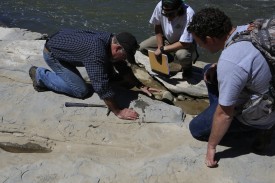Features Reporter
Courtesy photo by: Steven Troudt
Many CMU graduates go on to work in cities and offices, but for geology majors, most will go on to play in the dirt.
“Geology is kind of like being a little kid again. You do a lot of playing in the dirt and drawing stuff,” geology major Nikki Redden said.
A lot of the classwork is outside looking at rocks for certain details that lead to information about the rocks and land in the area.
“Fieldwork is how information is interpreted, about the history of the planet, about risks of building houses, structures on different types of rock,” Professor Jonathan Cooley said.
The area surrounding CMU is perfect for the geology program, especially this year as most of the rivers are lower than usual.
“The Bookcliffs are deposits left behind by an ocean about 80 some million years ago that split the North American continent,” Cooley said.
Due to this and other factors in history, the valley surrounding Grand Junction is a major place for fossils and oil. This allows many of the geology classes to take field trips, which allows the majors to experience fieldwork first hand.
“A lot of the lab work is what you can infer from biology and fossils,” geology major Maris Boraas said. “If a rock unit is from the ocean or a lake, depending on what fossils you find in it.”
This knowledge can help oil and gas companies calibrate how far down they are drilling by what kind of rocks and minerals they are removing from the ground. When Boraas graduates, she wants to do this kind of thing by using microfossils.
“A lot of oil and gas companies use microfossils to determine what rock layer they are drilling into,” Boraas said. “When you get the drill bit down in there, it crushes up the rock too bad, and any big fossils will be crushed up.”
Another way that rock formation structure helps provide information is through the imprint of dinosaur tracks. Geology student Stacy Bjenu is working on a project that compares dinosaur tracks here with other track ways known in the area.
“Dinosaurs were there and left their footprints in the sand, and now over 150 million years later they are still there today, which is really neat,” Bjenu said. “Given what we see in the local area, we can compare that to what we see out east, in what is called the New York Supergroup. It’s the exact same.”
This helps geologists to get a better sense for timing of events locally, nationally, and worldwide.
Boraas is also working on a research project.
“A research project I’m doing this semester is looking at a rock formation around here that is similar to what they are finding on Mars,” Boraas said. “We’re looking at a few things. One is that you don’t find fossils in this unit, so how could you tell that life was there based on traces you leave behind and how can you relate that to what the rovers on Mars are looking for as far as chemistry of the rocks?”
Overall, the geology major is both childlike and highly informational.
“There is just so much to it. You incorporate all the other sciences we take: biology, chemistry, physics, math, English, writing, and you put it all in one package,” Redden said. “You’re telling the story of the earth through so many forms.”
jkirk@mavs.coloradomesa.edu

Recent Comments